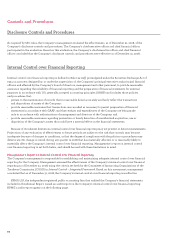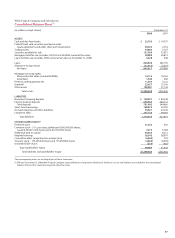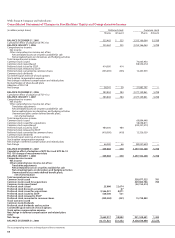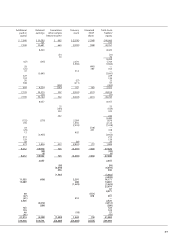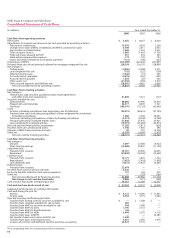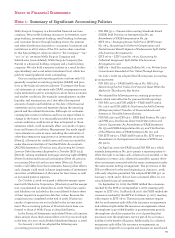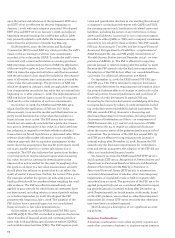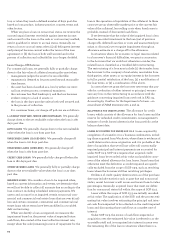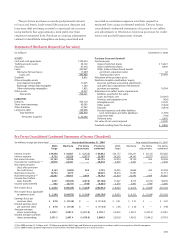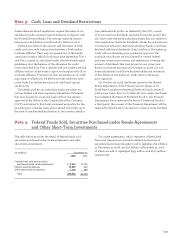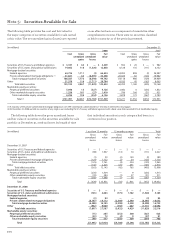Wells Fargo 2008 Annual Report Download - page 96
Download and view the complete annual report
Please find page 96 of the 2008 Wells Fargo annual report below. You can navigate through the pages in the report by either clicking on the pages listed below, or by using the keyword search tool below to find specific information within the annual report.
Because of the hybrid nature of these securities, we evalu-
ate PPS for other-than-temporary impairment using the
model we use for debt securities as described above. Among
the factors we consider in our evaluation of PPS are whether
there is any evidence of deterioration in the credit of the
issuer as indicated by a decline in cash flows or a rating
agency downgrade and the estimated recovery period.
Additionally, in determining if there was evidence of credit
deterioration, we evaluate: (1) the severity of decline in mar-
ket value below cost, (2) the period of time for which the
decline in fair value has existed, and (3) the financial condi-
tion and near-term prospects of the issuer, including any spe-
cific events which may influence the operations of the issuer.
We consider PPS to be impaired on an other-than-temporary
basis if it is probable that the issuer will be unable to make its
contractual payments or if we no longer believe the security
will recover within the estimated recovery period.
In 2008, we recorded $1,057 million of other-than-tempo-
rary impairment on PPS issued by Government Sponsored
Enterprises and corporations. None of our investments in
PPS that have not been impaired had been downgraded below
investment grade, and management believes that there are
no factors to suggest that we will not fully realize our invest-
ment in these instruments over a reasonable recovery period.
For marketable equity securities, we also consider the
issuer’s financial condition, capital strength, and near-term
prospects.
For debt securities and for PPS, which are treated as
debt securities for the purpose of other-than-temporary
impairment, we also consider:
• the cause of the price decline such as the general level of
interest rates and industry and issuer-specific factors;
• the issuer’s financial condition, near-term prospects and
current ability to make future payments in a timely manner;
• the issuer’s ability to service debt;
• any change in agencies’ ratings at evaluation date from
acquisition date and any likely imminent action; and
• for asset-backed securities, the credit performance of the
underlying collateral, including delinquency rates, cumu-
lative losses to date, and the remaining credit enhance-
ment compared to expected credit losses.
The securities portfolio is an integral part of our
asset/liability management process. We manage these
investments to provide liquidity, manage interest rate risk
and maximize portfolio yield within capital risk limits
approved by management and the Board of Directors and
monitored by the Corporate Asset/Liability Management
Committee (Corporate ALCO). We recognize realized gains
and losses on the sale of these securities in noninterest
income using the specific identification method.
Unamortized premiums and discounts are recognized in
interest income over the contractual life of the security using
the interest method. As principal repayments are received on
securities (i.e., primarily mortgage-backed securities) a pro-
rata portion of the unamortized premium or discount is rec-
ognized in interest income.
NONMARKETABLE EQUITY SECURITIES Nonmarketable equity
securities include venture capital equity securities that are not
publicly traded and securities acquired for various purposes,
such as to meet regulatory requirements (for example, Federal
Reserve Bank and Federal Home Loan Bank stock). These
securities are accounted for under the cost or equity method
or are carried at fair value and are included in other assets.
We review those assets accounted for under the cost or equity
method at least quarterly for possible other-than-temporary
impairment. Our review typically includes an analysis of the
facts and circumstances of each investment, the expectations
for the investment’s cash flows and capital needs, the viability
of its business model and our exit strategy. We reduce the
asset value when we consider declines in value to be other
than temporary. We recognize the estimated loss as a loss
from equity investments in noninterest income.
Nonmarketable equity securities that fall within the scope
of the AICPA Investment Company Audit Guide are carried at
fair value (principal investments). Principal investments,
including certain public equity and non-public securities and
certain investments in private equity funds, are recorded at
fair value with realized and unrealized gains and losses
included in gains and losses on equity investments in the
income statement, and are included in other assets in the bal-
ance sheet. Public equity investments are valued using quoted
market prices and discounts are only applied when there are
trading restrictions that are an attribute of the investment.
Private direct investments are valued using metrics such
as security prices of comparable public companies, acquisi-
tion prices for similar companies and original investment
purchase price multiples, while also incorporating a portfolio
company’s financial performance and specific factors. For
certain fund investments, where the best estimates of fair
value were primarily determined based upon fund sponsor
data, we use the net asset value (NAV) provided by the fund
sponsor as an appropriate measure of fair value. In some
cases, such NAVs require adjustments based on certain unob-
servable inputs. In situations where a portion of an invest-
ment in a non-public security or fund is sold, we recognize a
realized gain or loss on the portion sold and an unrealized
gain or loss on the portion retained.
Securities Purchased and Sold Agreements
Securities purchased under resale agreements and securities
sold under repurchase agreements are generally accounted
for as collateralized financing transactions and are recorded
at the acquisition or sale price plus accrued interest. It is our
policy to take possession of securities purchased under resale
agreements, which are primarily U.S. Government and
Government agency securities. We monitor the market value
of securities purchased and sold, and obtain collateral from
or return it to counterparties when appropriate.
Mortgages Held for Sale
Mortgages held for sale (MHFS) include commercial and res-
idential mortgages originated for sale and securitization in
the secondary market, which is our principal market, or for


